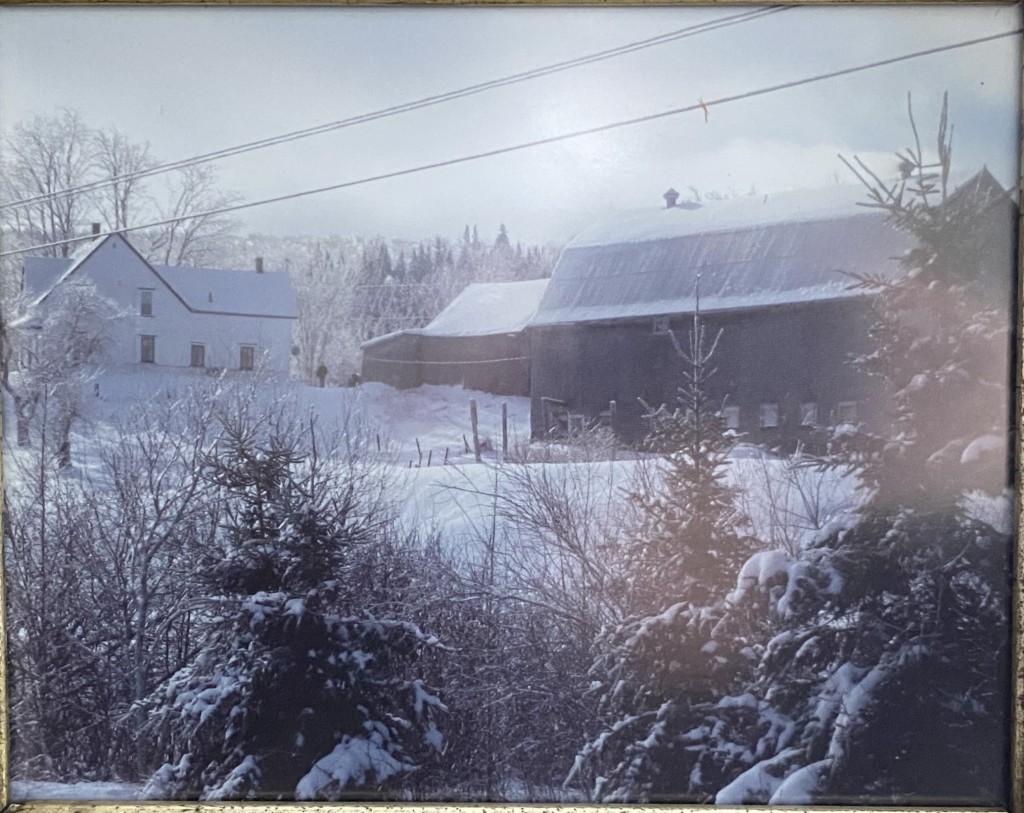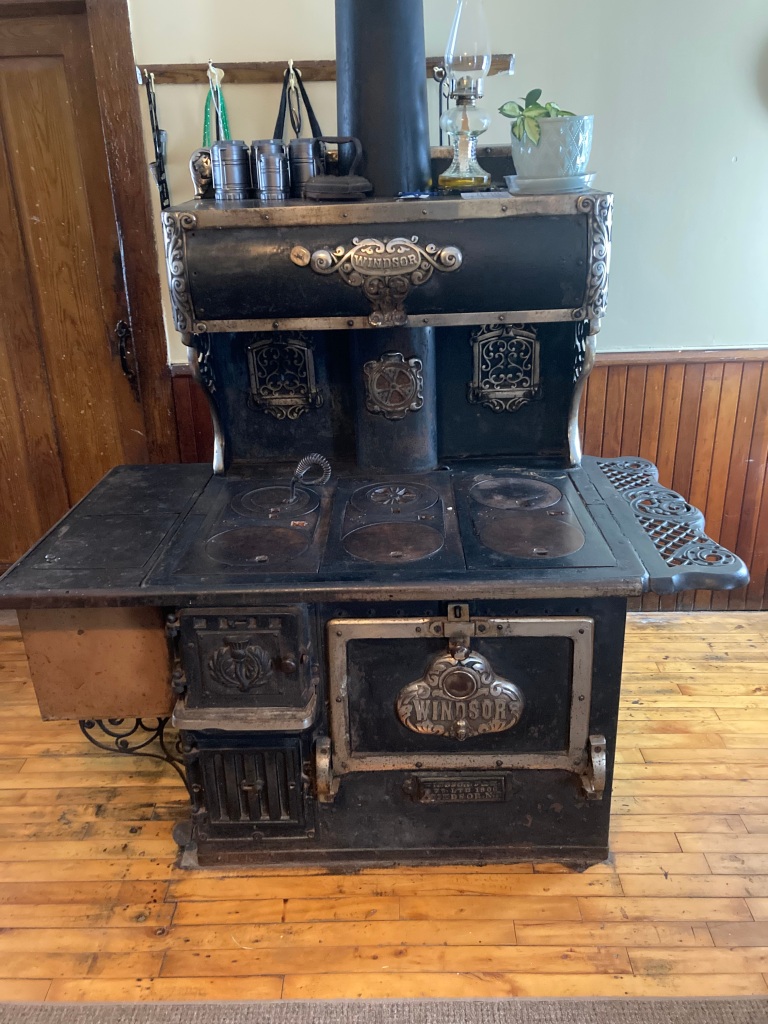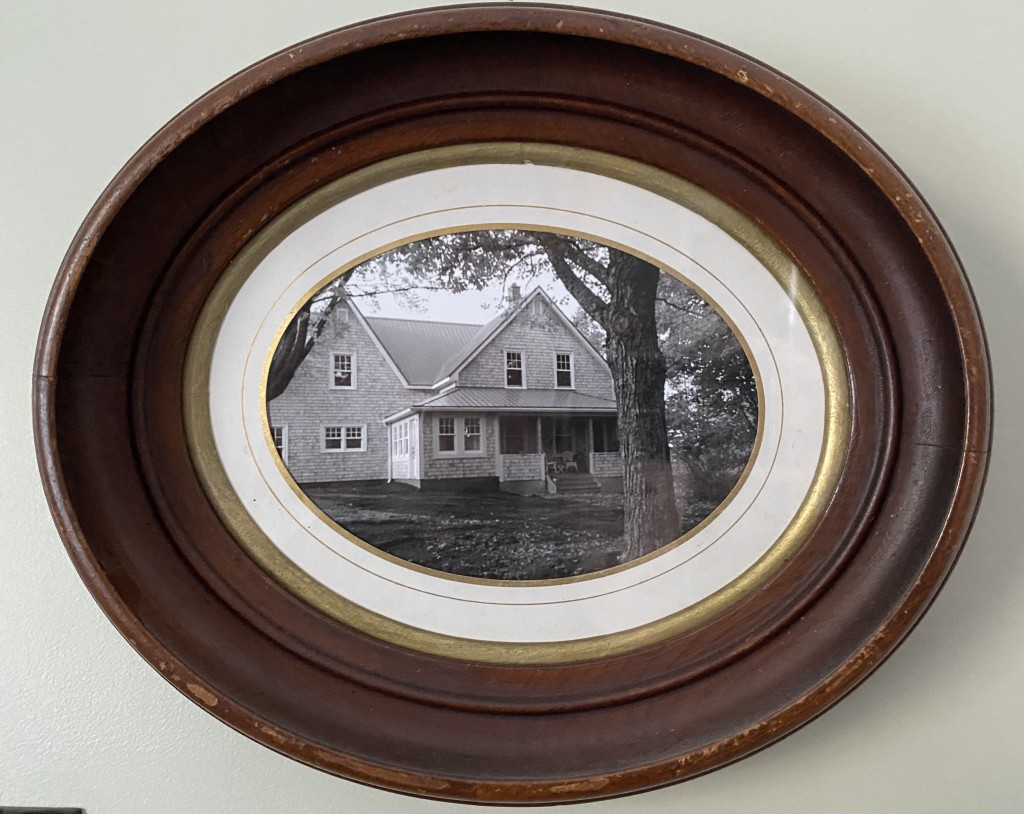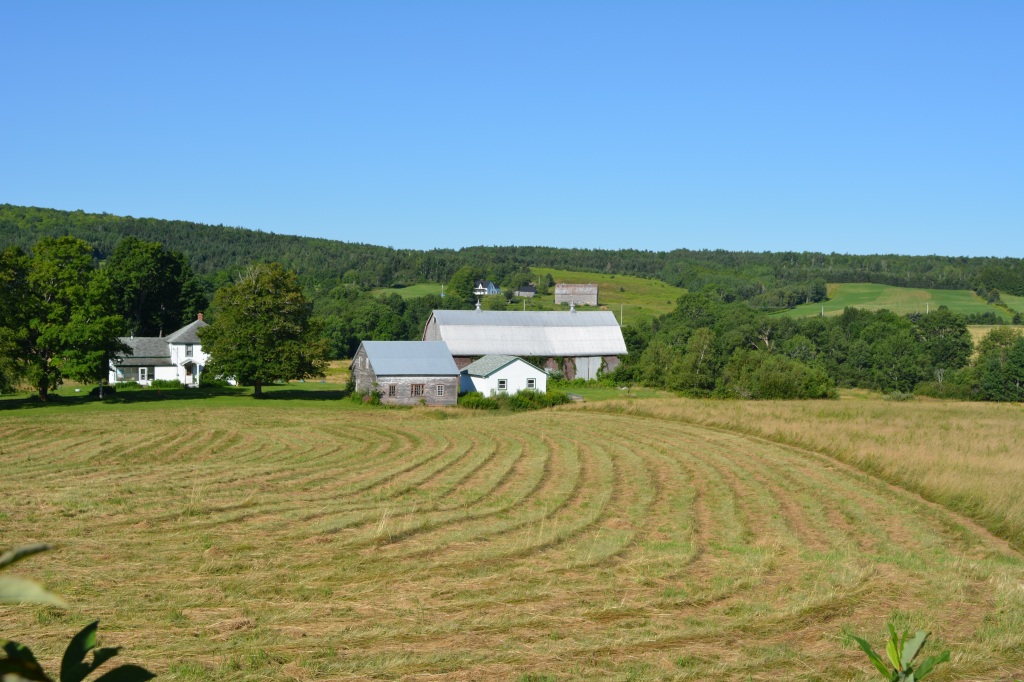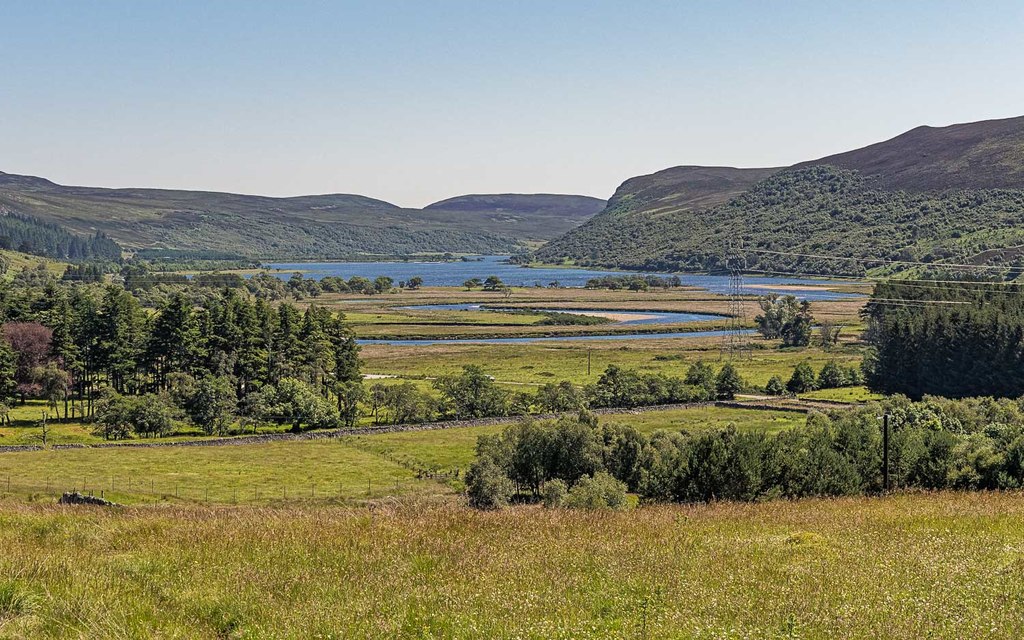by Joyce Ferguson
In 1980, my father Jack Ferguson moved to the John Will MacLeod farm on the McLeod Road. The large white house is perched on the rise of a steep hill and the barn (built in the early 1900s) is still in use. In 2011, my husband (Rémi Lemoine) and I purchased the Don & Joyce MacLeod house in The Falls, located on Highway 311 just south of the McLeod Road and in 2017, we took possession of my father’s property. John Will and Don both descended from Donald MacLeod & Barbara Gunn: John Will would have been a grandson and Don a great-grandson. (See a detailed history of the land ownership in posts on the MacLeod Road Farms (September 2014) and the MacLeod Family series in the past few weeks).
My father came to the John Will farm in 1980 with a “rent to buy” agreement and the formal sale was finalized within a few years. My siblings and I were always sure that Dad would eventually purchase the farm as the “out kitchen” contained a huge wood stove with a raised thistle design on the firebox door. Dad was very proud of the Ferguson crest with its thistle and a bee on the blossom. Alice Sutherland MacKay (the daughter of John Sutherland & Mary Henderson and was the mother of Dan MacKay) remembers that when she was a small child all the neighbours came to see the MacLeod’s wondrous new stove. Alice would have been a very young child. The stove was built in Windsor, Nova Scotia in 1906. It had a metal receptacle attached to the left of the firebox to create and hold heated water for washing. Imagine the magic of having warm water at the ready without the hassle of large pots on the stove!
As previously posted, a portion of the farm to the south was given to Donald & Barbara’s son William and his wife Georgena (gravestone spelling) Sutherland and then passed to their son George (Geordie) and his wife Anna Ferguson. Anna was a daughter from the Big Sandy Ferguson & Elizabeth MacKay family of the Ferguson Brook Road. Elisabeth MacKay’s mother was Janet Ferguson, a sister to my great-great-great-grandfather Alexander Ferguson (wife Mary Gordon) of Spiddle Hill who also had immigrated to Nova Scotia from the Parish of Clyne in Sutherlandshire around 1821. This means I have a “cousin connection” to the property.
Not only the MacLeods, but the women they married (Gunns, MacKays, Sutherlands and Fergusons) were from Sutherlandshire and were Highland Scots. These people were not very far removed from the ways and traditions of the old country as they established themselves on their land. Highland Scots of this time period were known to be strict church adherents but there was also a strong streak of the old superstitions, a love of ghost stories and tales of those who possessed the second sight (such as my great- grandmother, Christena Gunn Ferguson). The renovation of the two houses revealed a piece of this tradition.
The first house I will talk about is the one we currently live in. We believe this house may be the second home built on the property by William & Georgena. Most couples starting out built a small house and as fortunes improved would build a larger structure for their growing family. In the 1871 census, they are living in a separate dwelling from William’s parents and have two children plus a Margaret MacLeod living with them. I am making a guess that this was William’s unmarried Aunt Margaret (the 1871 census has her age at 69 and born in Scotland). The early residents of The Falls were no strangers to tragedy. Sadly, Georgena died less than three weeks after giving birth to Geordie in 1886. It is probable that Geordie was born in this house
During renovations of the house we found two newspaper sheets in the walls that dated from 1885. It is possible that the newspaper could have been added at a later date to the house but how it was placed in the wall would make this seem unlikely. There were also some pieces of newsprint recording the prime ministers of England ending with Mr. Gladstone who served until June 1885. On the back of this paper are some written notes listing the duties of a school trustee and a partial sentence about the “…attempt to establish a school”. I wonder if this was the foundation for establishing the school at The Falls. An inquiry to Glen revealed that a school was in two former nearby locations before the present site. The final location also resulted in a new building constructed around 1896. There were also some math calculations on a ragged piece of paper with Jessie Hayman written on the back.
We were gutting the house to install new wiring and insulation when my husband, Rémi, called for my help. He was tearing out the inside wall boards of the house (neither of the MacLeod houses had lathe and plaster but instead had wide horizontal planks for walls). He had found a small bottle, similar to a vanilla bottle in size, in the wall above the window. The bottle was very dirty and had some dried “gunk” coating the inside. I took the bottle and rinsed it out. The drained water was stained a reddish yellow colour. I put more water in the bottle and gave it another swish and out came more discoloured water and a feather. I surmised that this must have a meaning. I walked up the hill to get some service for my cell phone and Googled “bottle with a feather in it found inside an old house”. Straight away up popped “witches’ bottle”.
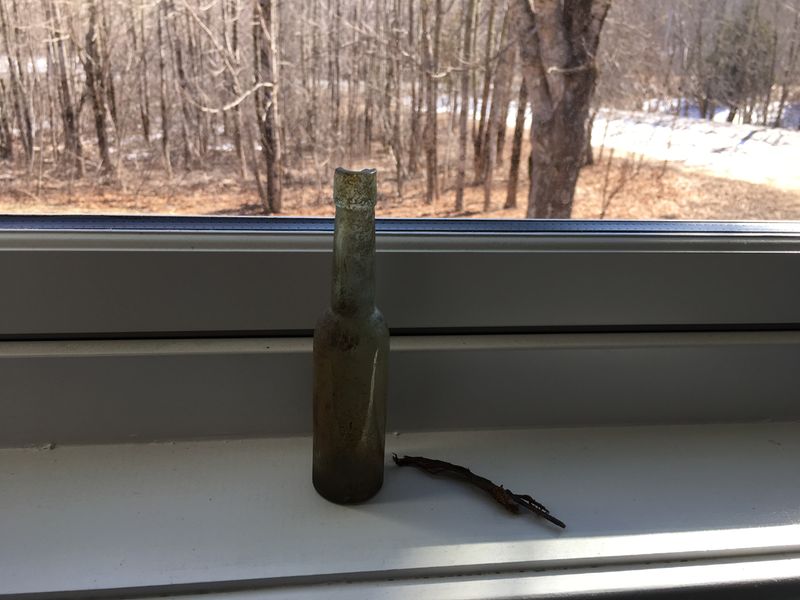
In Scotland, Ireland and the rest of the British Isles, there is a tradition of putting witches’ bottles in a hidden spot in the house to, of course, keep witches away. A bottle would usually be filled with personal items such as hair, nail clippings, thread, buttons, iron nails, or as in our case, a feather. The vessel would then be topped up with either urine or blood and closed up inside the house.
My next call from Rémi was to come and help him remove a vast quantity of broken glass and chards of crockery above two other windows. There were two intact glass bottles but the rest was just a mess of broken bits. Pieces of the crockery showed that someone liked pretty dishes with lots of blue and white and some of the red and white transferware that I am partial to. The glass and pottery were certainly deliberately placed above the windows top sill. Mixed in with the glass were items of clothing and some papers. The clothing seemed to be small such as children’s clothing would be. The cloth was in complete tatters as mice and squirrels had used them for nesting materials so we burned them.
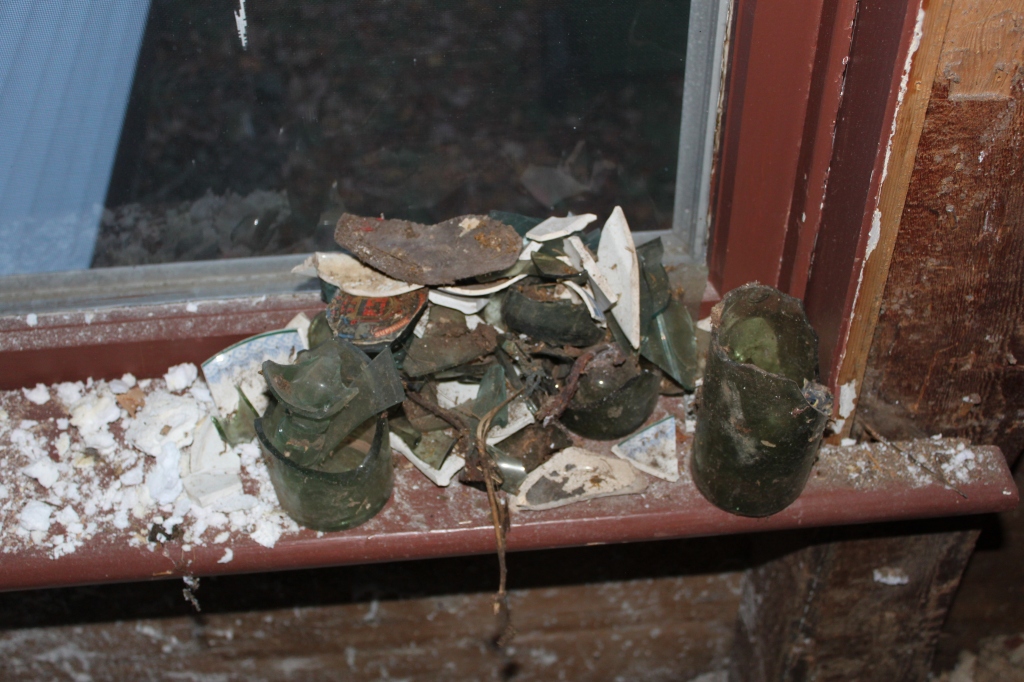
Next came the footwear. There were three complete pairs of shoes and parts of one or two others. The three pairs we could identify were of a man’s, a lady’s, and one small child’s copper- toed shoes. These are called concealment shoes. The shoes are supposed to protect you. Sometimes it might only be one shoe that you find. One theory is that the sole of a shoe is basically the symbol of your soul. The imprint your foot makes in a well-worn pair of shoes is very personal and considered powerful. No other piece of clothing moulds to your body the way footwear does. Concealment shoes are usually found near openings to the house such as windows, doors, and fireplaces. They can be found under the hearth or in old wall bread-ovens. Ours, as I said, were all found above windows.

The shoes can also be a fertility charm. Remember the very old tradition of throwing slippers at newlyweds? That tradition morphed into stringing shoes to the bumper of the honeymoon car in later generations. In Lancashire County, England, there is a tradition that women who want to get pregnant try on the shoe of someone who has just given birth. However, it seems most historians adhere to the theory that the main reason for concealment shoes was for protection. In Scotland and England, brownies and hobs were domestic fairies and could be gotten rid of by the gift of clothing. Perhaps that is why there was clothing in the wall.
The earliest known concealment shoe comes from 1308, and was found in Winchester Cathedral behind choir stalls that records show were installed during that year. The shoes have been found in many types of buildings-from humble homes to grand country houses, inns, factories and two Oxford colleges. The tradition is mostly British but the shoes can be found in Australia, the New England States, Germany, and, of course, here in Canada. There is a museum in Northampton, England, that maintains an index of concealment shoes which stands at over 2,000 reports. The practice of concealment shoes seems to have died out around the late 1800s and early 1900s.
We also found a metal button, a metal fork with a wooden handle, a small iron shoe-last (the form used to make shoes), and a piece of ornate iron that looks like it came off an old woodstove. Iron is thought to ward off or provide protection from devils, fairies, spirits and witches. I remember this from Helen Creighton’s book Bluenose Ghosts and other publications on folklore that I have read. Iron horseshoes were particularly powerful and still today are hung over the entry way to a house or barn (always hung like a U to keep your luck from running out!). Folklore suggests witches and spirits do not like to pass through iron. That is why iron fences were put around graveyards to (hopefully!) keep spirits in.
There were also some wooden items: a stave from a wooden bucket, a piece of moulding like that of a chair rail, a wooden spoon, a piece of tree root (that might have been used as a binding for a bucket or small cask), a long twig (which my Uncle Ralph wonders might have been used for water divining), and a small wooden child’s shoe last. We found pieces of harness, leather and nails.
The oddest item we found was a wooden bedpost placed upright between the studs in the wall near a window. The carving of the bedpost had not been completed. The question is why wasn’t it finished? There seems to be something about unfinished items put in the walls although I could not find anything in a Google search about this practice. We have friends in New Brunswick who found a concealment shoe and with it was a piece of unfinished embroidery sampler with the needle and thread still in place waiting for the woman to come back to complete it.
In all, we had one heaping laundry hamper plus the bed post found in the walls.
Our story continues. A few years later, I was cleaning up the shards of glass and bottles for a presentation and I came across one of the intact bottles. It was dirty but I could tell no strange liquid had been left in it although there was some dust and debris in the bottom. When I washed out the bottle out dropped a lump. It seemed to have a backbone. On closer inspection it was a small bat. I believe this was also a witches’ bottle as there was no evidence of bats having ever been in the house.
We started the renovation of my father’s house (the house of Donald MacLeod & Barbara Gunn) in 2017. We believe this house was built around the mid-1800s. The windows were made with wooden pegs and the window glass was very wavy. The boards used for the walls were much wider than those in our house of circa 1885. The timber beams in the basement are hand hewn.
Above a bookshelf on an outside wall beside a window we found some more items: a horseshoe, wooden lady’s shoe last, broken glass and crockery, part of a horse bit, wooden thread spools (which were invented in Paisley, Scotland, in 1820), pieces of wood, bones, wooden tool bits, a hammer, a clasp for suspenders, and metal hooks. We have not torn out the walls over the windows so who knows what else lies hidden behind the walls!
I have talked to some other people in the area who have also found items in the walls. I knew someone who owns the Gavin Bell farm in West New Annan who was going to do some renovations to the house. I suggested he keep a lookout for items hidden in the walls. Over one of the doors to the outside he found a large iron key. Again the key was completely sealed into the cavity so it was not likely it was a key someone was expecting to use. This would indicate that those who settled from the Dumfriesshire area of southern Scotland also partook in these traditions.
To finish off our story, in William & Georgena’s house put some items back into the walls. They will stay on the property and I have some objects displayed in a cabinet such as the witches’ bottle and some crockery. When we built the addition on our house we placed a pair of our daughter’s ballet slippers and sneakers belonging to our boys underneath the west windows. We did this to honour the tradition of the house and, since to date we haven’t seen any witches or nasty spirits “out and about” in The Falls, it must work!
